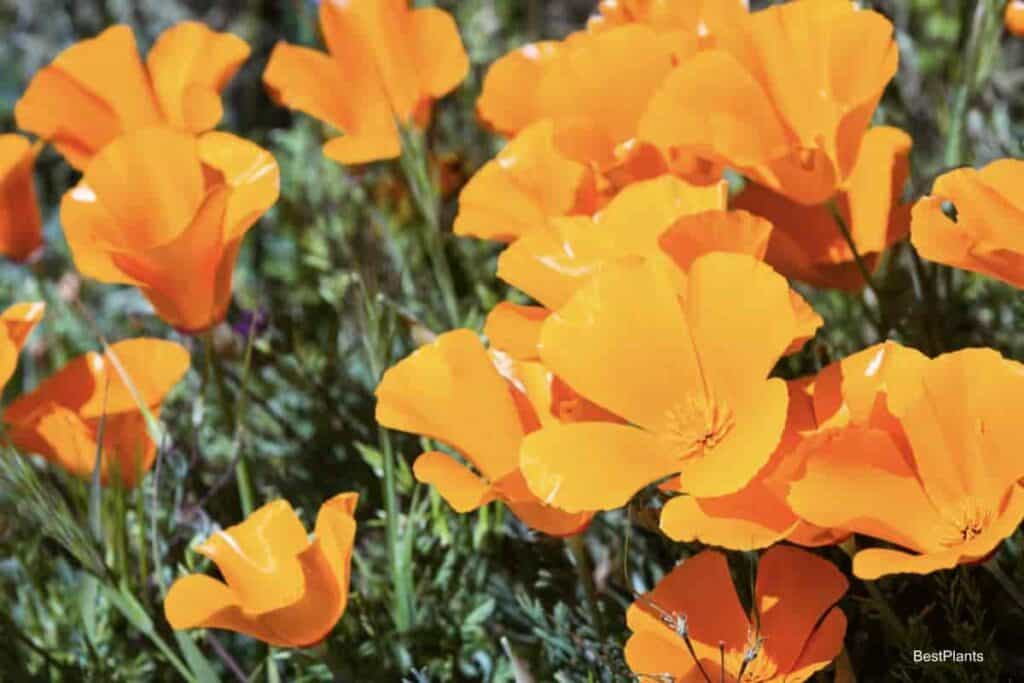There’s a special sparkle in the garden when you plant annual poppies. It’s impossible to duplicate it with any other annual, for the poppy has a built-in charm and showiness quite different in effect.
Being among the few annuals that thrive on heat and drought, resent pre-planting and transplanting fuss, and shrug away insects, poppies are invaluable as easy-to-manage flowers.

Most of us are familiar with the spectacular splendor of the perennial Oriental poppies. But often, we disregard the annual varieties that can be used to such an exciting advantage somewhere in the garden every summer.
You don’t just plant any old poppy and hope for the best, for there are now engaging and delightful choices among singles, doubles, and semi-doubles. They may be silky cups, begonia, carnation, rose, or tulip-flowered, depending on the variety chosen.
Iceland Poppies – Papaver Nudicaule
The Iceland poppies (Papaver nudicaule), although true perennials, seldom can endure severe winters. Except in warm localities, they must be planted each spring as an annual.
How showy and handsome the Icelands have become! They have acquired new colors, larger blossoms with a satiny sheen, and stems that are longer and more sturdy. There is:
- ‘Pink Champagne,’ with four-inch silky cups in warm, gold-bordered pink on 20″-inch stems
- ‘Red Cardinal,’ the first red among Iceland poppies, with giant scarlet cups
- A brilliant mixture, ‘Imperial Jewels,’ a glowing blend of scarlet to deep and pastel pinks.
- ‘White Silk’ can be a snowy contrast for any or all the Icelands.
California poppies (Eschscholzia californica), also true perennials, must have the same annual treatment as Icelands except in warm sections of the country. They have the added attraction of unusually handsome foliage, blue-green and finely cut, to set off the bright blossoms.
Lower and of more spreading growth than most poppies, the Californias are more oval than cupped.
At night or on dark days, their buds stay tightly rolled. Newer hybrid varieties furnish a broad range and double flowers that are softly frilled or picotee-edged. Good mixes of California poppies are the ‘Mission Bells’ hybrids.
Perfect For Paths and Rock Gardens
The Californias are perfect for edges of sunny paths, rock gardens, and walls, or any other place where a rainbow-topped green mound would be enjoyed.
There’s enjoyment in prospect, too, when you plant a packet of tulip poppies (Papaver glaucum). These are dazzlers, with their quantities of pointed scarlet “tulips” rising on 20″-inch stems above gray-green foliage.
Tulip poppies are too seldom seen. Try them silhouetted against a louvered windbreak or patio screen or glowing like coals among gray rocks.
Have you tried the double Shirley poppies, ‘Sweet Briar?’ You shouldn’t go on depriving yourself of such charming flowers.
Like giant full-blown roses in an exquisite warm pink, the ‘Sweet Briars’ paint delectable pictures, either alone or planted with such companions as nicotiana or annual baby’s-breath. Or try them behind fluted white petunias such as ‘Snow Storm.’
Other Shirley poppies hold bright potential too. There are doubles and singles ranging from the single black centered orange-scarlet called ‘Flanders’ Field,’ through shades of salmon, rose, pink and white, to the double carnation flowered sorts that are horticultural forms of the opium poppy (Papaver somniferum).
These are the huge fluffy-topped poppies on rugged plants that require a foot of space apiece to attain their magnificent proportions. Separate colors can be snow-white, lilac, and sometimes purple. Mixtures will contain all the poppy colors.
The fluffy tops are real beauties. Even one specimen plant, well grown, is a conversation piece. Its full flowers, almost six inches across, from a distance resemble peonies.
Plant Poppies Early
Seeds for all annual poppies should be planted as early in spring as the ground can be prepared. Their place in full sun should be well loosened and raked to a fine, smooth surface.
If the seeds are distributed from a salt shaker, half-filled with fine sand, they will cover a great deal more area, with less thinning required. It’s almost useless to attempt to transplant poppy seedlings, for they simply don’t survive it.
With the seed pressed in firmly and the bed kept moistened, they’ll be up in less than three weeks. When they are an inch or more high, they can be thinned to three or four inches apart, then later to a final eight to ten. This is important, for poppies will not reach perfection if they’re crowded for room.
Seed pods, if allowed to form, will lessen the bloom in both quantity and size. As soon as petals fall, the stalk should be cut off to keep the buds forming.
If care is taken with this simple chore, poppies will be blooming until frost. They thrive on minimum moisture and maximum heat, placing them among the easiest and showiest annuals possible.